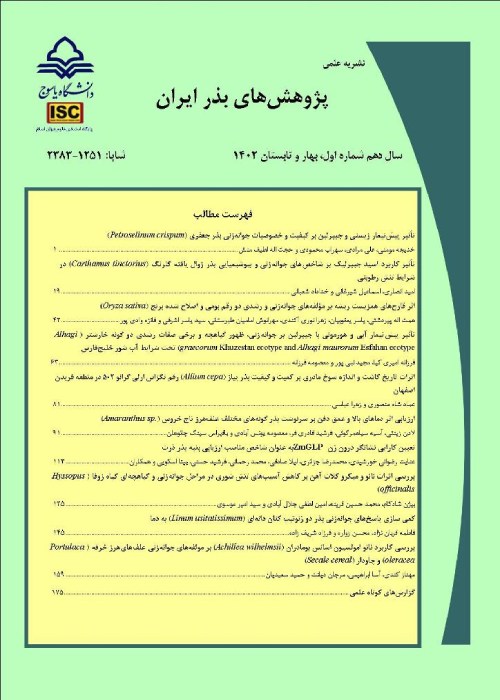Evaluation and Determination of the Salt Tolerance Threshold of Some Fenugreek (Trigonella foenum-graecum) Ecotypes at Seedling emergence Stage
Fenugreek, is a medicinal plant that has been considered as a salt tolerant crop. This research was conducted to investigate the effects of salt stress on seedling emergence characteristics and determination of the salt tolerance threshold, declivity of emergence and salt tolerance index of some fenugreek ecotypes.
Seeds of five ecotypes (Ardestani, Isfahani, hendi, Mashhadi, Neyrizi) were subjected to seven levels of salinity (0.5, 3, 6, 9, 12, 15 and 18 dS/m) in a factorial experiment based on a completely randomized design with three replications. In this research, experimental models (linear, sigmoidal, exponential and multi-component) were used.
Results showed that increasing levels of salinity decreased seedling emergence percentage and rate. In Ardestani and Isfahani ecotypes, increase of salinity up to 3 dS/m had no effect on seedling emergence percentage and thereafter, decreased it, significantly. The maximum seedling emergence percentage (94.62%) belonged to Hendi in control treatment. Hendi ecotype had also the highest emergence percentage (25.81%) at 18 dS/m. Although the highest seedling emergence rate (5.93 per day) belonged to Mashhadi ecotype in control treatment, it didn’t show any significant difference to Hendi, Neyrizi and Isfahani ecotypes. In Ardestani, Mashhadi and Neyrizi ecotypes, seedling length decreased significantly with increasing salinity, but this decrease was not significant in Isfahani ecotype between salinities of 3 and 6 dS/m and also 12 and 15 dS/m. In Hendi ecotype, seedling length at 3 dS/m was similar to control, but higher salinities caused a significant reduction. The maximum value of seedling vigor index (20.44) belonged to Mashhadi and Neyrizi ecotypes in control treatment and Ardestani ecotype had the lowest one (0.39) at 18 dS/m. Results showed that seedling dry weight was first unchanged up to salinity level of 3 dS/m and then gradually decreased with increasing salinity. In Hendi and Neyrizi ecotypes, applying salinities higher than 6 dS/m, gradually decreased seedling dry weight. The salt tolerance threshold of fenugreek for Ardestani, Isfahani, Hindi, Mashhadi and Neyrizi ecotypes was 4.69, 4.90, 7.83, 1.69 and 1.57 dS/m, respectively. Thus, the highest salt tolerance threshold (7.83 dS/m) and the declivity of emergence percentage (7.55%) was obtained from Hendi ecotype and the lowest one from Neyrizi ecotype (1.57 and 4.63 dS/m, respectively). Results of nonlinear models showed that the highest salinity in which 50 percent of seedlings emerged was obtained in Hendi ecotype (14.24 dS/m).
Based on the results, comparing the salt tolerance index of fenugreek ecotypes and also evaluating of some experimental models showed that Hendi ecotype may be introduced as the most tolerant ecotype to salinity stress at the emergence stage to exploit saline soil and water resources.
- حق عضویت دریافتی صرف حمایت از نشریات عضو و نگهداری، تکمیل و توسعه مگیران میشود.
- پرداخت حق اشتراک و دانلود مقالات اجازه بازنشر آن در سایر رسانههای چاپی و دیجیتال را به کاربر نمیدهد.



